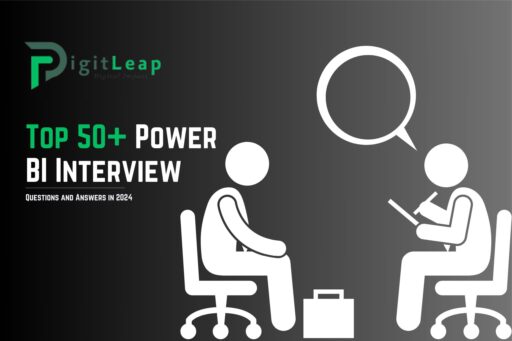Top 50 Power BI Interview Questions and Answers 2024
Power BI has become a key tool for business analytics, allowing professionals to visualize data and create insightful reports. Here’s a list of the top 50 Power BI interview questions and answers for 2024 that will help you prepare for interviews with confidence.
1. What is Power BI?
Answer:
Power BI is a business analytics service provided by Microsoft that allows users to connect to various data sources, transform the data, and create interactive reports and dashboards for insightful decision-making.
2. What are the components of Power BI?
Answer:
Power BI has several key components:
- Power Query: Data extraction and transformation.
- Power Pivot: Data modeling.
- Power View: Data visualization.
- Power Map: 3D geospatial data visualization.
- Power BI Desktop: Desktop-based report and dashboard creation tool.
- Power BI Service: Cloud-based platform for sharing reports.
- Power BI Mobile: Mobile app for viewing reports.
3. What is Power BI Desktop?
Answer:
Power BI Desktop is a free application installed on your local computer that allows users to connect to data sources, transform data, and create interactive reports and dashboards. It is primarily used for report creation and data modeling.
4. What is the Power BI Service?
Answer:
The Power BI Service is an online SaaS (Software as a Service) platform where users can publish, share, and collaborate on Power BI reports and dashboards. It enables access to Power BI content across various devices via the cloud.
5. What is DAX in Power BI?
Answer:
DAX (Data Analysis Expressions) is a collection of functions, operators, and constants used to create formulas and expressions in Power BI. It is used to perform advanced calculations and data analysis on data in Power BI.
6. What are some common DAX functions used in Power BI?
Answer:
- SUM: Adds up values in a column.
- AVERAGE: Returns the average of a column.
- MAX: Finds the maximum value.
- MIN: Finds the minimum value.
- COUNT: Counts the number of rows.
- CALCULATE: Modifies the context of a calculation.
7. What are the different data sources supported by Power BI?
Answer:
Power BI supports numerous data sources, including:
- Excel files
- SQL Server
- Azure SQL Database
- Oracle Database
- CSV and Text files
- SharePoint
- Google Analytics
- Salesforce
- MySQL, and many more.
8. What is a Power BI dashboard?
Answer:
A Power BI dashboard is a single-page visualization that summarizes key insights from various reports. Dashboards allow users to monitor data and track key performance indicators (KPIs) at a glance.
9. What is the difference between a report and a dashboard in Power BI?
Answer:
- Report: A multi-page collection of visualizations that are created from a dataset. It allows detailed analysis.
- Dashboard: A single-page view that summarizes insights using visuals from different reports.
10. What is Power Query in Power BI?
Answer:
Power Query is a data transformation and preparation engine that allows users to extract, clean, and transform data before importing it into Power BI for analysis. It supports a wide range of data sources.
11. What is the role of Power Pivot in Power BI?
Answer:
Power Pivot is used for creating data models and performing data analysis in Power BI. It allows users to create relationships between tables, define calculated columns, and create measures using DAX.
12. What are the different types of filters in Power BI?
Answer:
- Visual-Level Filters: Apply to a specific visual in a report.
- Page-Level Filters: Apply to all the visuals on a particular page.
- Report-Level Filters: Apply to all visuals and pages in the report.
13. What is a slicer in Power BI?
Answer:
A slicer is a visual filter in Power BI that allows users to interactively filter data in reports. It provides an intuitive way to segment data based on different fields.
14. What are calculated columns in Power BI?
Answer:
Calculated columns are columns created using DAX expressions within Power BI’s data model. These columns are based on existing data and allow for further analysis by adding new fields derived from the original dataset.
15. What are measures in Power BI?
Answer:
Measures are calculations created using DAX in Power BI. They perform dynamic calculations based on filters and context, such as sum, average, or percentage change, and are used to analyze data in visuals.
16. What is Power BI Gateway?
Answer:
Power BI Gateway is a bridge that connects on-premises data sources to Power BI services in the cloud, enabling scheduled refreshes and live queries without moving the data to the cloud.
17. What is Power BI Premium?
Answer:
Power BI Premium is a licensing model that provides dedicated cloud resources for Power BI, allowing for greater performance, larger datasets, and advanced features like paginated reports and dataflows.
18. What is Power BI Pro?
Answer:
Power BI Pro is a subscription-based service that allows users to create, publish, and share reports and dashboards in the Power BI Service. It includes collaboration features and enables users to export and embed reports.
19. What is the difference between Power BI Pro and Power BI Premium?
Answer:
- Power BI Pro: Individual license that enables creating, sharing, and collaborating on reports.
- Power BI Premium: Organizational license offering dedicated capacity, large datasets, and advanced features like paginated reports and AI capabilities.
20. What is Direct Query in Power BI?
Answer:
Direct Query is a method where Power BI retrieves data directly from the underlying data source rather than importing it. This ensures the most up-to-date data but can affect performance depending on the data source.
21. What is Power BI Embedded?
Answer:
Power BI Embedded allows developers to embed Power BI reports and dashboards into custom applications using REST APIs and client-side JavaScript.
22. How can you improve performance in Power BI?
Answer:
- Use aggregated tables to reduce data volume.
- Optimize DAX calculations by avoiding row-by-row calculations.
- Use Direct Query only when necessary.
- Enable data compression and reduce model size by removing unnecessary columns and rows.
23. What are Power BI apps?
Answer:
Power BI apps are packaged sets of dashboards and reports that can be distributed to users within an organization. They allow for easier sharing of insights and data across teams.
24. What is the use of Bookmarks in Power BI?
Answer:
Bookmarks capture the current state of a report, including filters, slicers, and drill-down levels. They allow users to quickly navigate between different views of the report.
25. What is the Q&A feature in Power BI?
Answer:
The Q&A feature allows users to ask questions about the data in natural language, and Power BI automatically generates relevant visuals to answer the query.
26. How can you secure data in Power BI?
Answer:
- Implement Row-Level Security (RLS) to restrict data access based on the user’s role.
- Use Azure Active Directory for authentication.
- Ensure Data Encryption both in transit and at rest.
27. What is Row-Level Security (RLS) in Power BI?
Answer:
Row-Level Security (RLS) restricts data access for specific users based on roles defined in Power BI. RLS can be set up by creating DAX expressions that filter the data accessible to users based on their roles.
28. What is the difference between Import and Direct Query in Power BI?
Answer:
- Import Mode: Data is imported into Power BI, allowing for fast querying but requiring manual refreshes.
- Direct Query Mode: Queries the data directly from the source, ensuring up-to-date data but potentially affecting performance.
29. What are Dataflows in Power BI?
Answer:
Dataflows allow users to create reusable ETL pipelines in Power BI by defining data extraction, transformation, and loading steps. These dataflows can be used across multiple Power BI reports.
30. How does Power BI handle big data?
Answer:
Power BI can handle big data by using:
- Direct Query to avoid importing large datasets.
- Aggregations to summarize large datasets.
- Power BI Premium for larger data models and dedicated resources.
31. What is incremental refresh in Power BI?
Answer:
Incremental refresh allows users to refresh only a portion of the data (such as recent data) instead of the entire dataset, reducing load times and improving performance.
32. What are data alerts in Power BI?
Answer:
Data alerts are notifications set on KPI or gauge visuals in Power BI. When data crosses a defined threshold, Power BI sends an alert to the user.
33. What is the use of Drillthrough in Power BI?
Answer:
Drillthrough allows users to navigate from one report page to another based on a particular selection. It provides detailed insights by focusing on specific data points.
34. What is the use of Tooltip in Power BI?
Answer:
Tooltips provide additional context when hovering over data points in a visual. Custom tooltips can be created to display more detailed information about a data point.
35. How can you schedule data refresh in Power BI?
Answer:
Data refresh can be scheduled in the Power BI Service by configuring the refresh settings for datasets. It can be set to refresh at specific intervals, ensuring up-to-date data.
36. What is the purpose of Aggregations in Power BI?
Answer:
Aggregations allow users to reduce the size of data models by summarizing data, such as grouping it by key metrics. This improves performance and allows for faster querying.
37. How do you integrate Power BI with other Microsoft products?
Answer:
Power BI integrates seamlessly with Microsoft products like Excel, Azure, and SharePoint. Data can be imported from these sources, and Power BI reports can be embedded in tools like Microsoft Teams and SharePoint.
38. What is the difference between Power BI and Tableau?
Answer:
- Power BI: More cost-effective, strong integration with Microsoft tools, and better for small to mid-sized organizations.
- Tableau: More advanced in terms of data visualization and scalability, often preferred by large enterprises.
39. How do you create relationships between tables in Power BI?
Answer:
In Power BI, relationships between tables can be created using the Model View. Primary and foreign keys are used to define how tables are related, allowing data to be analyzed across multiple tables.
40. What is Power BI REST API?
Answer:
The Power BI REST API enables developers to integrate Power BI functionalities into custom applications. It allows for programmatic access to reports, datasets, and dashboards.
41. What are KPIs in Power BI?
Answer:
KPIs (Key Performance Indicators) are visual tools used to evaluate the success of a business metric against a target. In Power BI, KPIs track the performance of specific measures over time.
42. How can you embed Power BI reports in an application?
Answer:
Power BI reports can be embedded in web applications using Power BI Embedded or Power BI REST API. This allows custom applications to display interactive reports seamlessly.
43. What is the use of the Analyze in Excel feature in Power BI?
Answer:
The Analyze in Excel feature allows users to connect to Power BI datasets using Excel’s pivot tables and charts. It is useful for users who are more comfortable with Excel.
44. What are paginated reports in Power BI?
Answer:
Paginated reports are pixel-perfect reports designed for printing or exporting, often used for generating detailed operational reports. These reports are available in Power BI Premium.
45. What is the difference between a table and a matrix visual in Power BI?
Answer:
- Table Visual: Displays data in rows and columns, similar to an Excel spreadsheet.
- Matrix Visual: Similar to a pivot table, it allows grouping and summarizing data across rows and columns.
46. How do you share a Power BI report?
Answer:
Reports in Power BI can be shared using:
- Share button: Direct sharing with specific users.
- Power BI Apps: Distributing reports through packaged apps.
- Embedding: Embedding reports in applications or websites.
47. What are custom visuals in Power BI?
Answer:
Custom visuals are third-party visuals created using the Power BI SDK that allow for more specialized visualizations. These can be downloaded from the Microsoft AppSource or created by developers.
48. What is drill-down in Power BI?
Answer:
Drill-down allows users to navigate from a high-level summary view to more detailed data in a hierarchy, such as drilling down from year to quarter or month.
49. How do you troubleshoot Power BI performance issues?
Answer:
- Optimize DAX queries and reduce complexity.
- Limit the use of Direct Query for large datasets.
- Use aggregations and summaries to minimize data volume.
- Remove unnecessary columns and tables from the model.
50. How do you export Power BI reports?
Answer:
Power BI reports can be exported in different formats, such as PDF, PowerPoint, or Excel, using the Export feature in the Power BI Service.
Download PDF Version
To make preparation easier, here is the PDF version of the Top 50 Power BI Interview Questions and Answers for 2024 that you can download for quick reference.
By reviewing these Power BI interview questions and answers, you’ll be ready to impress in your next Power BI job interview!
Other Important Q&A List :
- OOPs Interview Questions And Answers
- SQL Interview Questions and Answers
- Content Writing Interview Questions and Answers
- Email Marketing Interview Questions and Answers
- Django Interview Questions and Answers
- C Programming Interview Questions and Answers
- ReactJS Interview Questions and Answers
- Angular Interview Questions and Answers
- Power BI Interview Questions and Answers
- Top DBMS Interview Questions and Answers
- Python Interview Questions and Answers
- MySQL Interview Questions and Answers
- Java Interview Questions and Answers
- Data Structures Interview Questions
- Flutter Interview Questions and Answers
- JavaScript Interview Questions and Answers
- PHP Interview Questions and Answers
- CSS Interview Questions and Answers
- HTML Interview Questions and Answers






